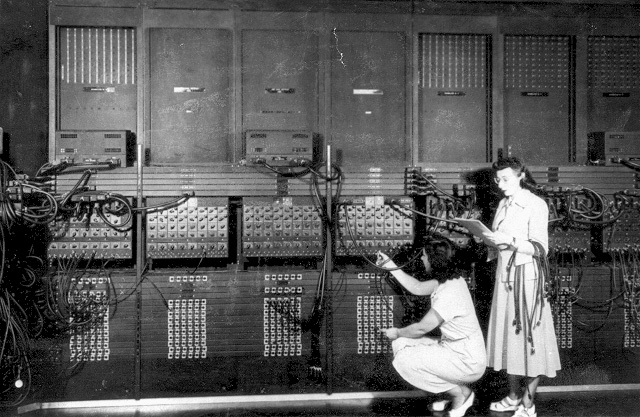70th Anniversary: ENIAC Contract Signed

The individual units of the ENIAC were rewired manually in order to run a new program. ABOVE: Programmers Gloria Ruth Gordon (Bolotsky) and Ester Gerston wire the right side of the computer according to the program specifications. Photo: US Army from archives of the ARL Technical Library, courtesy of Mike Muuss.
On May 17, 1943, the U.S. Army signed a contract with the University of Pennsylvania’s Moore School of Electrical Engineering to develop a computer for its Ballistics Research Library. Known as the Electronic Numerical Integrator And Computer, or ENIAC, its creation marked a major step in modern computing.
Unlike its predecessor, the British Colossus built solely for the purpose of code breaking, the ENIAC was the first computer developed for general purpose. Calculations that once took mathematicians three months to perform could now be completed in mere seconds. Although it was finished in 1946, too late for wartime ballistics calculations, the ENIAC was used to find solutions to complex mathematical problems in fields including atomic energy and rocketry.
In the 70 years since the inception of the ENIAC, computer science has changed dramatically. Where microprocessors in today’s computers can complete over 177 billion operations per second, the ENIAC could perform just 5,000 simple calculations in one second. Modern microprocessors are tiny and fit in palm of your hand; the ENIAC was a mammoth machine weighing 30 tons and spanning 80 feet. While current microprocessors use about 30 watts of electricity, the ENIAC gobbled up over 170,000 watts and was rumored to dim the lights in the city Philadelphia when it was switched on!
Despite their vast differences in size, speed, energy use, and programmability, the early computers developed for the war effort paved the way for modern computers. The legacy of the ENIAC is evident 70 years later, as the rate of technological innovation rapidly increases and computers are an integral part of daily life. It makes you stop and wonder, where will we be in another 70 years?
Thank you to Marie Hicks, Ph.D. for contributing to this post.
Post by Annie Tête, STEM Education Coordinator
- Posted :
- Post Category :
- Tags :
- Follow responses to this entry through the RSS 2.0 feed. You can skip to the end and leave a response. Pinging is currently not allowed.




Leave a Reply